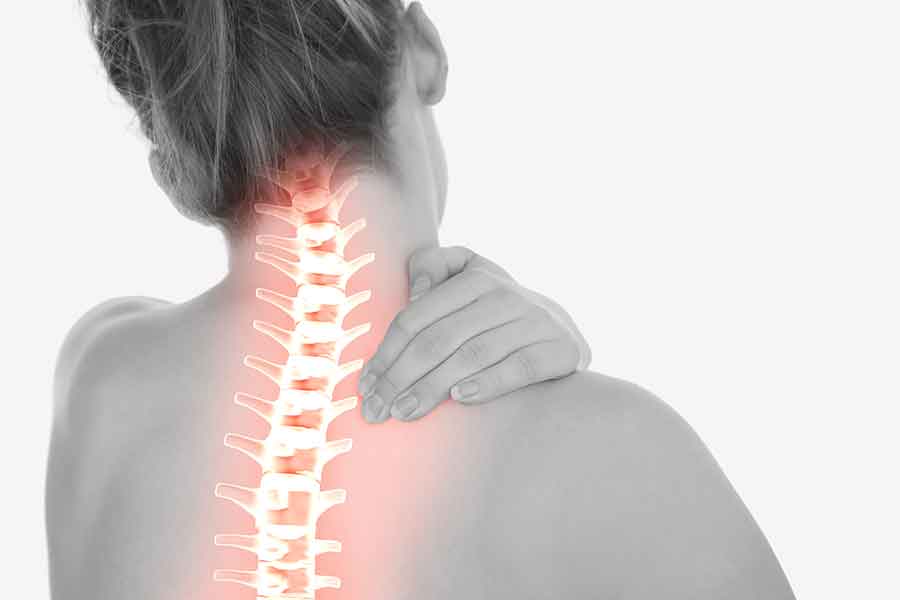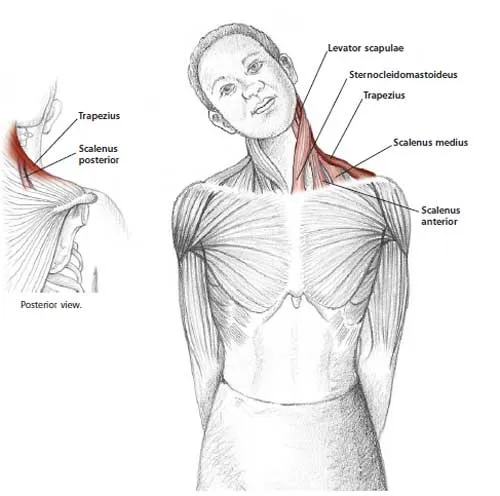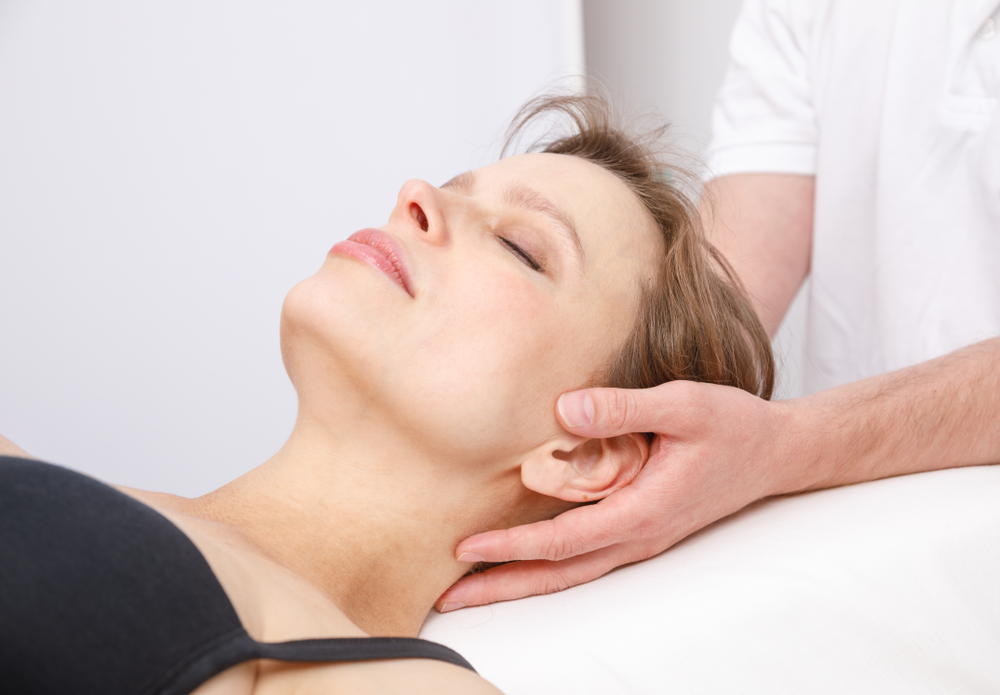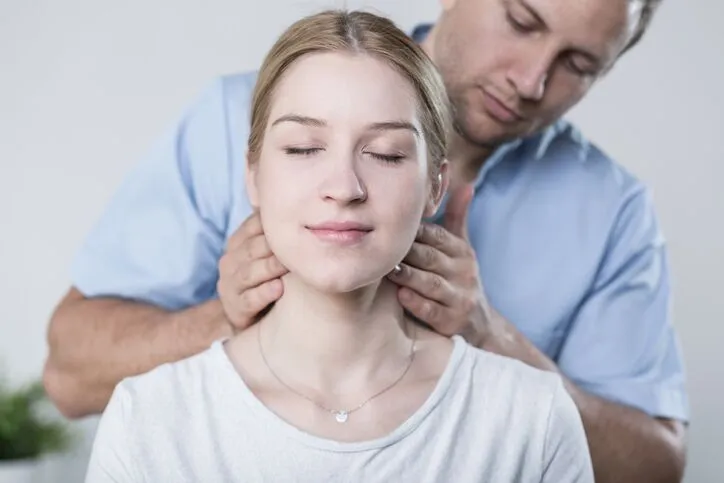Contents
Introduction:
Neck pain, a ubiquitous discomfort experienced by individuals of all ages, often manifests in the form of a bothersome “crook” or stiffness in the neck. This prevalent ailment can stem from a myriad of factors, ranging from poor posture and sedentary lifestyles to acute injuries and stress induced muscle tension. As a pivotal connector between the head and torso, the neck houses a complex network of muscles, ligaments, and vertebrae, making it susceptible to various strains and conditions.
Understanding the nuances of neck pain and its underlying causes is essential for implementing effective relief strategies. In this comprehensive guide, we delve into the multifaceted aspects of neck discomfort, exploring not only the symptoms and identification of a “crook” in the neck but also the proactive measures and professional interventions that can bring relief. Timely attention to neck pain is crucial, as it not only impacts daily activities but can also lead to chronic issues if left unaddressed.
We begin by examining the common causes of neck pain, shedding light on the intricacies of how poor ergonomics, muscle imbalances, and stress contribute to the development of a persistent crick in the neck. Acknowledging the significance of early intervention, we emphasize the importance of promptly addressing neck discomfort to prevent the escalation of symptoms and potential long term consequences.
In the subsequent sections, we delve into self care strategies that individuals can employ at home to alleviate neck pain. From gentle stretches that target specific neck muscles to the judicious application of heat and cold therapy, these practical tips aim to empower individuals with accessible and effective means of self management. We also explore the role of proper sleeping posture and stress management techniques, recognizing the interconnected nature of physical and emotional well being in the context of neck health.
Recognizing that over the counter medications can play a role in managing neck pain, we provide insights into the appropriate use of pain relievers and muscle relaxants. However, we underscore the importance of a balanced approach, combining pharmacological interventions with lifestyle adjustments for comprehensive relief.
As neck pain often necessitates professional evaluation and intervention, we delve into the world of healthcare practitioners. Physical therapy, chiropractic care, and massage therapy emerge as valuable allies in the quest for neck pain relief. We explore the specific techniques employed by these professionals and guide readers on how to choose a qualified practitioner.
In the realm of prevention, we offer practical advice on ergonomic considerations, neck strengthening exercises, and regular stretches. By incorporating these preventative measures into daily routines, individuals can take proactive steps toward maintaining a healthy and resilient neck.
Finally, we discuss the critical junctures at which seeking professional medical advice becomes imperative, highlighting the red flags that indicate the need for a thorough evaluation. Understanding when to consult a healthcare professional ensures that underlying issues are identified and addressed promptly.
In conclusion, this guide serves as a comprehensive resource for individuals seeking not only immediate relief from a crook in the neck but also a holistic understanding of neck health. By empowering readers with knowledge and actionable strategies, we aim to facilitate a proactive and informed approach to managing and preventing neck pain.

Understanding the Crook in Your Neck:
Neck pain, often characterized by a vexing “crook” or stiffness, necessitates a nuanced exploration of its manifestations and contributing factors. In this section, we delve into the intricate details of understanding the crook in your neck, aiming to provide readers with a comprehensive grasp of the symptoms, triggers, and indications that prompt the need for professional intervention.
At its core, a crook in the neck manifests as discomfort, tightness, or restricted mobility in the cervical region. By exploring the nuanced symptoms experienced by individuals, we aim to facilitate self awareness and early recognition of neck pain. Understanding these symptoms is crucial, as they can vary from mild tension to sharp, localized pain, often accompanied by headaches and difficulty in turning the head.
Identifying potential triggers for a crook in the neck involves examining both acute incidents and chronic factors. Acute causes may include sudden twists or jerks, such as those experienced during a fall or a vehicular accident. Chronic contributors, on the other hand, often involve poor ergonomics, prolonged periods of poor posture, or stress induced muscle tension. By unraveling the interconnected web of triggers, individuals can gain insights into the root causes of their neck discomfort.
Recognizing when to seek professional help is paramount in addressing a crook in the neck comprehensively. Persistent or worsening symptoms, especially when accompanied by neurological symptoms like numbness or tingling, should not be ignored. Additionally, understanding the red flags that indicate a potential underlying condition, such as herniated discs or cervical radiculopathy, empowers individuals to make informed decisions about seeking medical attention.
In the subsequent sections of this guide, we will explore actionable strategies for self care, encompassing gentle neck stretches, heat and cold therapy, proper sleeping posture, and stress management techniques. These approaches not only provide immediate relief but also contribute to the overall understanding of neck health.

By unraveling the intricacies of the crook in your neck, we aim to equip readers with the knowledge needed to navigate their journey towards relief and recovery. Whether the discomfort is a result of a recent injury or a culmination of lifestyle factors, a deeper understanding of symptoms and triggers sets the stage for targeted and effective interventions.
Home Remedies and Self Care:
Addressing a crook in the neck often begins with practical and accessible self care strategies that individuals can implement at home. In this section, we explore a range of home remedies designed to alleviate neck pain, promote flexibility, and contribute to overall well being. These self care practices aim to empower individuals with proactive measures they can integrate into their daily routines for ongoing neck health.
Gentle Neck Stretches:
Neck Tilt Exercises:
- Description of proper form and execution.
- Emphasis on gradual movements and avoiding sudden jerks.
Neck Rotation Exercises:
- Instructions for safe rotation to enhance flexibility.
- Importance of maintaining a pain free range of motion.
Neck Flexor Stretches:
- Techniques for stretching the front neck muscles.
- Emphasis on gentle and controlled movements.

Heat and Cold Therapy:
Application of Ice Packs:
- Proper use of ice packs for reducing inflammation.
- Duration and frequency considerations for safe application.
Warm Compresses for Muscle Relaxation:
- Benefits of heat therapy in promoting blood flow and relaxation.
- Cautionary notes on avoiding excessive heat and prolonged application.
Proper Sleeping Posture:
Choosing the Right Pillow:
- Considerations for pillow height and firmness based on sleep position.
- Importance of maintaining neutral spine alignment.
Sleeping Position Adjustments:
- Recommendations for side, back, and stomach sleepers.
- Use of additional supports, such as a rolled towel or cervical pillow.
Stress Management Techniques:
Relaxation Exercises:
- Introduction to deep breathing, meditation, and progressive muscle relaxation.
- Integration of mindfulness practices into daily routines.
Breathing Techniques:
- Demonstration of diaphragmatic breathing for stress reduction.
- Incorporating breath awareness for relaxation.

By incorporating these home remedies into daily life, individuals can actively participate in their recovery from a crook in the neck. These self care practices not only provide relief from immediate discomfort but also foster a deeper connection to one’s body, promoting overall well being. In the subsequent sections, we will explore additional avenues for relief, including over the counter medications and professional interventions, ensuring a holistic and informed approach to managing neck pain.
Over the Counter Medications:
When addressing a crook in the neck, over the counter (OTC) medications can serve as valuable tools in managing pain and discomfort. In this section, we explore the types of medications commonly available without a prescription, their appropriate uses, and considerations for effective relief.
Pain Relievers:
Acetaminophen:
- Explanation of how acetaminophen works to reduce pain.
- Recommended dosage and potential side effects.
Nonsteroidal Anti Inflammatory Drugs (NSAIDs):
- Overview of NSAIDs and their anti inflammatory properties.
- Cautionary notes regarding long term use and gastrointestinal effects.
Muscle Relaxants:
Appropriate Usage and Precautions:
- Understanding the role of muscle relaxants in managing neck pain.
- Guidance on the short term use and potential side effects.
Potential Side Effects:
- Common side effects and situations requiring medical attention.
- Interaction considerations with other medications.
While OTC medications can provide relief, it’s essential to use them judiciously and be aware of potential risks. Individuals with pre existing health conditions or those taking other medications should consult with a healthcare professional before using OTC options. Additionally, these medications are part of a comprehensive approach that includes self care strategies and, when necessary, professional interventions.
Professional Interventions:
For individuals seeking targeted and expert care to address a crook in the neck, professional interventions offer valuable avenues for relief. In this section, we explore three key approaches: physical therapy, chiropractic care, and massage therapy. Each modality brings a unique set of techniques and benefits, contributing to the comprehensive management of neck pain.
Physical Therapy:
Neck Exercises Under Supervision:
- Importance of personalized exercise plans tailored to individual needs.
- Collaboration with a physical therapist for proper form and progression.
Manual Therapy Techniques:
- Hands on techniques such as joint mobilization and soft tissue massage.
- Application of therapeutic exercises to improve strength and flexibility.

Chiropractic Care:
Adjustments and Manipulations:
- Explanation of spinal adjustments for realignment.
- Recognition of the chiropractic subluxation model.
Evaluation by a Qualified Chiropractor:
- Considerations for choosing a reputable and licensed chiropractor.
- Initial assessments and ongoing monitoring during treatment.
Massage Therapy:
Benefits of Massage for Neck Pain:
- Exploration of how massage alleviates muscle tension and improves circulation.
- Identification of specific massage techniques for neck pain relief.
Choosing a Certified Massage Therapist:
- Considerations for selecting a licensed and experienced massage therapist.
- Communication with the therapist regarding specific concerns and preferences.
Understanding the nuances of each professional intervention empowers individuals to make informed choices based on their preferences and the nature of their neck pain. It’s crucial to consult with healthcare professionals to determine the most suitable approach and ensure that these interventions align with individual health conditions.
Prevention Strategies:
Beyond addressing the immediate symptoms of a crook in the neck, implementing prevention strategies is essential for long term neck health. In this section, we explore proactive measures that individuals can incorporate into their daily lives to reduce the risk of developing neck pain and discomfort.
Ergonomic Considerations:
Proper Desk and Chair Setup:
- Adjusting the height and positioning of workstations for optimal ergonomics.
- Incorporating supportive chairs and desks to reduce strain.
- Regular Breaks During Prolonged Activities:
- Importance of taking breaks during extended periods of sitting or repetitive tasks.
- Simple stretches and movements to prevent stiffness.
Neck Strengthening Exercises:
Incorporating Resistance Training:
- Overview of resistance exercises to build neck strength.
- Gradual progression and adaptation based on individual fitness levels.
- Balancing Exercises for Stability:
- Integration of exercises targeting neck stability and core strength.
- Incorporating balance challenges for a comprehensive approach.

Regular Neck and Shoulder Stretches:
Implementing a Daily Stretching Routine:
- Importance of consistency in maintaining flexibility.
- Quick and effective stretching exercises for the neck and shoulders.
- Incorporating Stretches into Daily Activities:
- Tips for integrating stretches into routine tasks, such as during breaks or while commuting.
- Creating a mindful approach to posture throughout the day.
By embracing these prevention strategies, individuals can take an active role in maintaining a healthy and resilient neck. These practices not only contribute to reducing the likelihood of developing neck pain but also enhance overall well being and posture. Prevention is a dynamic process that involves continuous awareness and adjustments to lifestyle factors.
When to Consult a Healthcare Professional:
While self care strategies and preventive measures play a crucial role in managing neck pain, there are instances where consulting a healthcare professional becomes imperative. In this section, we explore the red flags and indicators that signal the need for professional evaluation and intervention.
Persistent or Worsening Symptoms:
- Recognition of prolonged discomfort despite self care efforts.
- Understanding when persistent pain requires professional evaluation.
- Importance of tracking changes in symptoms over time.
Signs of a More Serious Underlying Condition:
Numbness or Tingling:
- Identification of neurological symptoms indicating potential nerve involvement.
- The significance of addressing sensory changes promptly.
Radiating Pain or Headaches:
- Understanding pain patterns that extend beyond the neck.
- Possible implications for spinal or nerve related issues.
Loss of Mobility or Function:
- Recognition of significant limitations in neck movement.
- Indications of potential structural or musculoskeletal concerns.
Importance of Professional Evaluation and Diagnosis:
Timely Intervention for Underlying Conditions:
- Seeking prompt medical attention for accurate diagnosis.
- The role of diagnostic imaging and tests in identifying specific issues.
Collaborative Approach to Treatment:
- Working with healthcare professionals to create a tailored treatment plan.
- Incorporating medical advice into self care strategies for comprehensive management.
Understanding when to consult a healthcare professional ensures that underlying issues are identified and addressed promptly. Timely intervention not only alleviates immediate concerns but also minimizes the risk of complications and long term consequences. Individuals experiencing persistent or concerning symptoms should prioritize seeking professional evaluation to receive appropriate care.

Conclusion:
In concluding our comprehensive guide to relieving a crook in the neck, we summarize the key strategies and insights offered to empower individuals in managing and preventing neck pain. This journey has taken us through an in depth exploration of symptoms, triggers, and various approaches to relief, fostering a holistic understanding of neck health.
Recap of Key Strategies for Relieving a Crook in the Neck:
Understanding Symptoms and Triggers:
- Recognition of symptoms and identification of potential triggers.
- Importance of self awareness in managing neck discomfort.
Self Care Practices at Home:
- Incorporation of gentle neck stretches, heat and cold therapy, proper sleeping posture, and stress management techniques.
- Empowering individuals with practical and accessible tools for immediate relief.
Over the Counter Medications:
- Judicious use of pain relievers and muscle relaxants for targeted relief.
- Considerations for potential side effects and interactions.
Professional Interventions:
- Exploration of physical therapy, chiropractic care, and massage therapy.
- Understanding the unique benefits and considerations of each approach.
Prevention Strategies:
- Ergonomic considerations, neck strengthening exercises, and regular stretches.
- Promotion of proactive measures for long term neck health.
Recognizing When to Consult a Healthcare Professional:
- Identification of persistent or concerning symptoms.
- Awareness of red flags signaling potential underlying conditions.
Emphasizing the Significance of Ongoing Neck Care and Preventive Measures:
Integration of Prevention into Daily Life:
- Ergonomic adjustments, strength building exercises, and regular stretches as part of routine activities.
- Fostering a proactive approach to neck health to prevent future episodes of discomfort.
Collaborative and Informed Decision Making:
- Seeking professional advice when needed.
- Combining self care practices with professional interventions for a comprehensive strategy.
Mindful Attention to Overall Well Being:
- Acknowledging the interconnected nature of physical and emotional health.
- Incorporating holistic practices for enhanced quality of life.
As we conclude, it is essential to recognize that neck health is a dynamic and ongoing process. By staying attuned to one’s body, implementing preventative measures, and seeking professional guidance when necessary, individuals can cultivate resilience and well being in the face of neck pain. This guide serves as a resource for informed decision making, empowering individuals on their journey towards optimal neck health.
